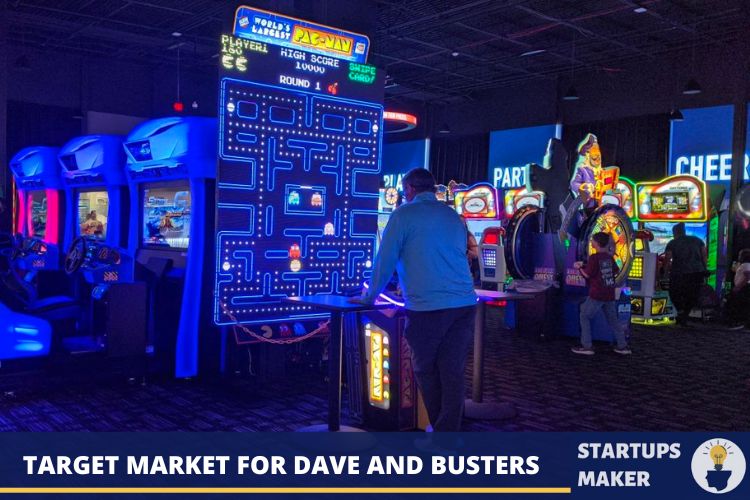Information about Who is the target market for Dave and Busters is essential to the creation of successful marketing mix tactics, which are dependent on that knowledge. If the organisation knows who is Dave and Busters target audience, then the strategy will have a greater chance of being successful. The in-depth investigation of “Who is the target market for Dave and Busters” ultimately results in the classification of customers into a number of distinct categories or groups.
Who is Dave and Busters Target Audience?
In order to understand who is Dave and Busters target audience, one may proceed with following steps:
- To begin, Dave Buster’s Entertainment, Inc. must make it very obvious who their existing consumers and future customers are. At this point, a full group of consumers is recognised so that it may be separated into several segments depending on the motives, features, and characteristics of the individuals who make up those segments. The identification of who is Dave and Busters target audience can be more difficult than the identification of existing customers.
- The customer analysis should include information regarding the ways in which the wants and expectations of various groups are distinct from one another, as well as the factors that may be responsible for these distinctions. This will help to understand who is target market for Dave and Busters.
- In conclusion, Dave Buster’s Entertainment, Inc. need to investigate how the product or service it provides satisfies the requirements of various consumer groups, as well as who is Dave and Busters target audience for increased profits and expansion. Dave Buster’s Entertainment, Inc. will be able to construct customer profiles and personas with the use of this information.
Read:- Goodwill Franchise Cost | Open a Goodwill Store
Constructing Dave and Buster’s Consumer Profiles
When constructing their consumer profiles, Dave and Buster’s Entertainment, Inc. might take into consideration the following factors:
- Who is Dave and Busters target audience needs to determine the entire size of the market, which should include both existing and prospective clients and should be able to be broken down into a number of quantifiable subgroups.
- The client profiles ought to have some discernible points of differentiation amongst them. In addition to that, the organisation needs to carry out behavioural study in order to determine the psychographic profiles. In the process of making a purchase decision, which is more generally referred to as purchasing criteria, it requires determining and evaluating who is the target market for Dave and Busters. The most common factors for purchasing decisions are prestige, convenience, quality, and cost.
Read:- 1800 Flowers Franchise {Cost, Fees & Opportunities}
After that, Dave Buster’s Entertainment, Inc. will be able to construct who is Dave and Busters target audience. The following are important components that should be considered while designing client personas:
- Data pertaining to demographics (e.g. gender, family, age, location etc.)
- Channels of communication that are preferred.
- Possible influencers (publications or celebrities they follow), the difficulties they suffer as a result of unmet requirements, and the solutions they want to see implemented.
4 Strategies for Directing Customers to Dave & Buster’s Entertainment, Inc.
After segmenting the large, diverse customer market into smaller groups with similar characteristics, Dave & Buster’s Entertainment, Inc. should make an informed decision regarding which who is the target market for Dave and Busters. The company’s resources and capabilities should be aligned with the requirements of the target segment or segments.
- The process of understanding who is Dave and Busters target audience may be accomplished by assessing the commercial allure and expansion capacity of the segments that have been identified.
- Dave Buster’s Entertainment, Inc. has the ability to choose one or more market segments, based on the features of those market categories, as well as the resources, capabilities, and growth goals of the firm.
- Utilizing the following indications will allow for the evaluation of each segment’s potential for development as well as its potential for commercial attractiveness:
- The measured sizes of the identified segments are accurate.
- Have real distinctions.
- The projected earnings need to be in excess of the supplementary advertising expenditures.
- The segments are quite simple to access.
- It is now necessary for Dave Buster’s Entertainment, Inc. to establish a crystal clear positioning statement in order to generate a favourable image of the product being offered in the customers’ minds. This step follows the segmentation of the customer market and understanding who is the target market for Dave and Busters. The following are some of the actions that Dave Buster’s Entertainment, Inc. may take in order to build an efficient positioning strategy:
- By providing responses to the following questions, you may develop the positioning statement for Dave Buster’s Entertainment Inc.’s marketing strategy:
- What does your company’s name stand for?
- What are the things that people in your target market desire and need?
- How does your brand fulfil those requirements?
- How does your product or service compare to those offered by competitors?
The information that can be gleaned from the responses to these questions will be sufficient for developing a positioning statement. A comparison of their communication and messaging strategy with that of their rivals will show possible problem areas that may be fixed with a strategically focused positioning statement.
Also Read: DHL Franchise {Cost, Fees & Opportunities}
Some Other Considerations
Determine the advantages and disadvantages of the company by analysing its competition and who is the target market for Dave and Busters. Examine how your rivals are positioned in the market, and assess where you stand in comparison.
Create a positioning statement by making use of the analytical data obtained from the various market, customer, and competitor studies, and then assess its efficacy on a quarterly basis by gathering qualitative and quantitative data (like focus groups, polls, interviews etc.).
